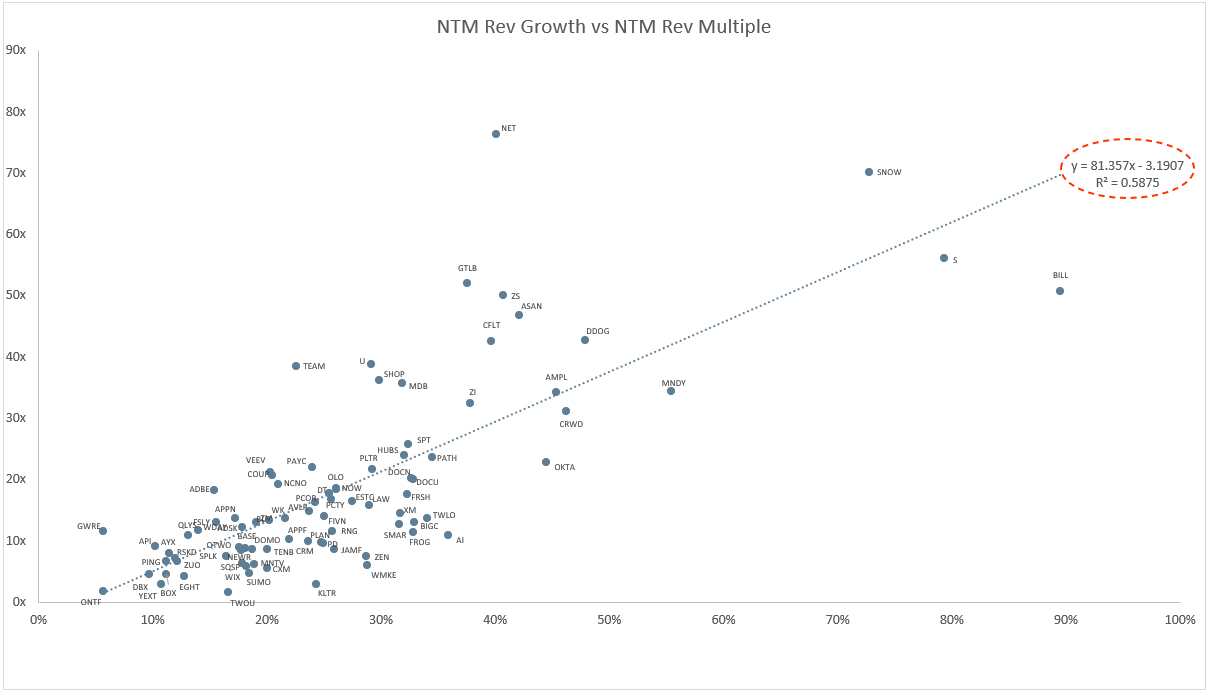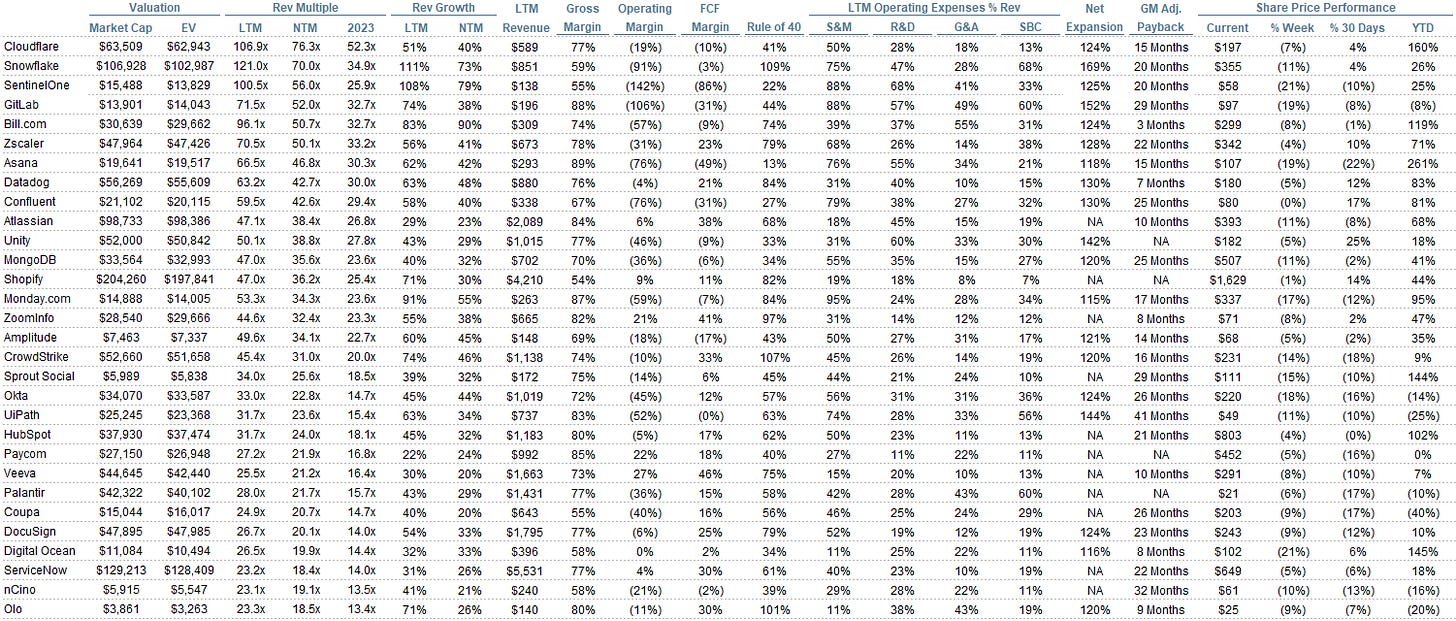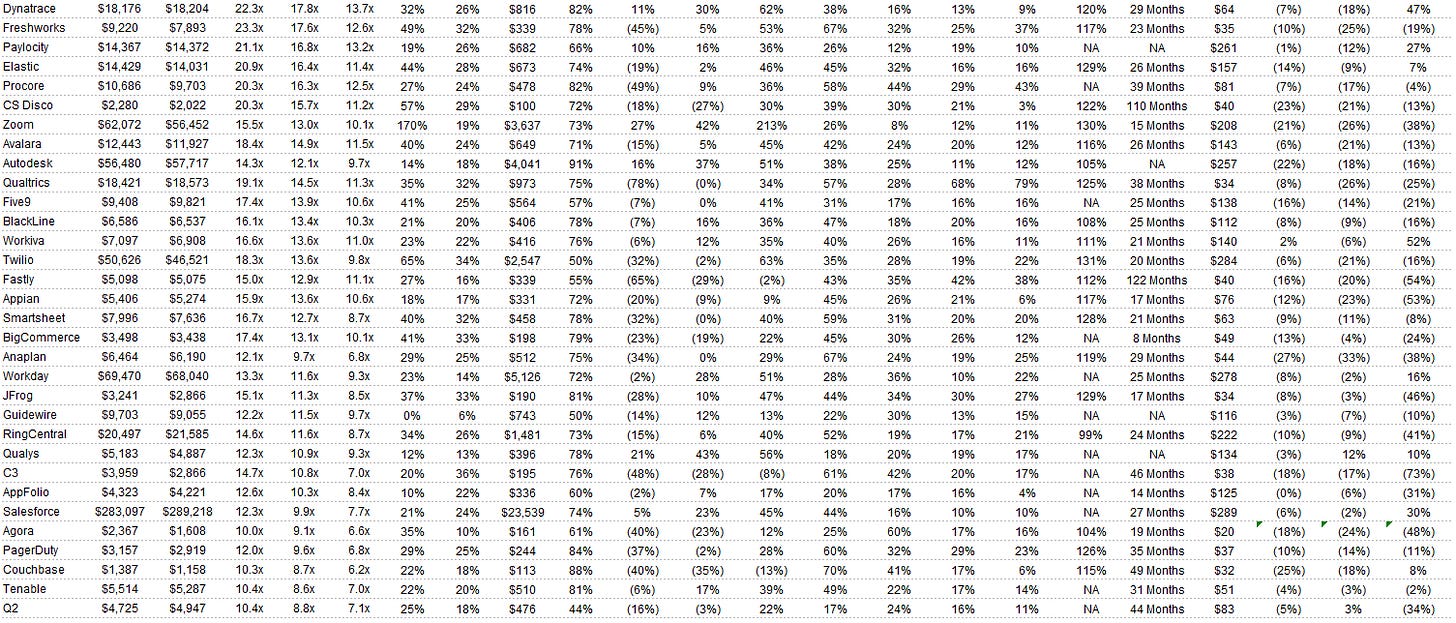Clouded Judgement 11.26.21
Every week I’ll provide updates on the latest trends in cloud software companies. Follow along to stay up to date!
This week’s selloff
What a week for cloud software. The few companies to report (Zoom, Anaplan, Autodesk) all fell roughly 15-20%. Many other companies fell >10%, and some >20%. Of the ~90 cloud software companies I track only 3 of them are trading higher than where they were 1 week ago, and the median change from last week was a 10% drop. What’s driving this? Probably a few things - most notably, real rates are rising.
Let’s first talk about the difference between nominal rates and real rates. Interest rates are often talked about in relation to high growth assets. High growth assets (long duration) are more prone to flocculation in interest rates. Nominal rates are what you hear quoted most frequently (ie the 10 year treasury). Nominal rates represent the stated interest rate of a bond or loan. Real interest rates factors in inflation, which give the borrower a better picture of their purchasing power. The way you calculate the real interest rate is to subtract inflation from the nominal interest rate. As an example, if nominal interest rates were 5%, and inflation was 2%, the real interest rate would be 3%.
Over the last few months we’re heard talks of rising rates, but this was often accompanied by a rise of expected inflation, so real rates stayed very low. However, recently we saw a rise in real rates as inflation expectations came down a bit (according to the market) and nominal interest rate expectations are rising given Powell confirmed he’s more hawkish. Hawkish is a monetary policy term to describe policy that uses increasing interest rates to keep inflation under control. The expectation that real rates will continue to rise has lead to a broder rotation in the equity markets away from high growth long duration assets into “safer” sections. Within software, we’ve seen the large/mega-cap (FCF supported) businesses like Microsoft, Salesforce, Adobe, Salesforce fare much better over the last week than their high growth peers.
It may be easy to read the last couple paragraphs and say “all we need is higher inflation and real rates will go back to 0 and multiples will rise again!” This isn’t entirely accurate. While I do think there’s an argument that high growth software can be an inflationary hedge, there is a reality where inflation has negative impacts on earnings performance, which effects IT budgets. This is more of a longer term effect. All of this to say, coming out of Covid we’re still in a very interesting, and volatile, market for cloud software!
My colleague Chris Conforti posted some nice charts on real rates this week:


Quarterly Reports Summary
Top 10 EV / NTM Revenue Multiples
Top 10 Weekly Share Price Movement
Update on Multiples
SaaS businesses are valued on a multiple of their revenue - in most cases the projected revenue for the next 12 months. Multiples shown below are calculated by taking the Enterprise Value (market cap + debt - cash) / NTM revenue.
Overall Stats:
Overall Median: 13.5x
Top 5 Median: 56.0x
3 Month Trailing Average: 15.8x
1 Year Trailing Average: 16.1x
Bucketed by Growth. In the buckets below I consider high growth >30% projected NTM growth, mid growth 15%-30% and low growth <15%
High Growth Median: 31.0x
Mid Growth Median: 12.9x
Low Growth Median: 6.6x
Scatter Plot of EV / NTM Rev Multiple vs NTM Rev Growth
How correlated is growth to valuation multiple?
Growth Adjusted EV / NTM Rev
The below chart shows the EV / NTM revenue multiple divided by NTM consensus growth expectations. The goal of this graph is to show how relatively cheap / expensive each stock is relative to their growth expectations
Operating Metrics
Median NTM growth rate: 25%
Median LTM growth rate: 32%
Median Gross Margin: 75%
Median Operating Margin (19%)
Median FCF Margin: 5%
Median Net Retention: 119%
Median CAC Payback: 25 months
Median S&M % Revenue: 44%
Median R&D % Revenue: 26%
Median G&A % Revenue: 19%
Comps Output
Rule of 40 shows LTM growth rate + LTM FCF Margin. FCF calculated as Cash Flow from Operations - Capital Expenditures
GM Adjusted Payback is calculated as: (Previous Q S&M) / (Net New ARR in Q x Gross Margin) x 12 . It shows the number of months it takes for a SaaS business to payback their fully burdened CAC on a gross profit basis. Most public companies don’t report net new ARR, so I’m taking an implied ARR metric (quarterly subscription revenue x 4). Net new ARR is simply the ARR of the current quarter, minus the ARR of the previous quarter. Companies that do not disclose subscription rev have been left out of the analysis and are listed as NA.
This post and the information presented are intended for informational purposes only. The views expressed herein are the author’s alone and do not constitute an offer to sell, or a recommendation to purchase, or a solicitation of an offer to buy, any security, nor a recommendation for any investment product or service. While certain information contained herein has been obtained from sources believed to be reliable, neither the author nor any of his employers or their affiliates have independently verified this information, and its accuracy and completeness cannot be guaranteed. Accordingly, no representation or warranty, express or implied, is made as to, and no reliance should be placed on, the fairness, accuracy, timeliness or completeness of this information. The author and all employers and their affiliated persons assume no liability for this information and no obligation to update the information or analysis contained herein in the future.













